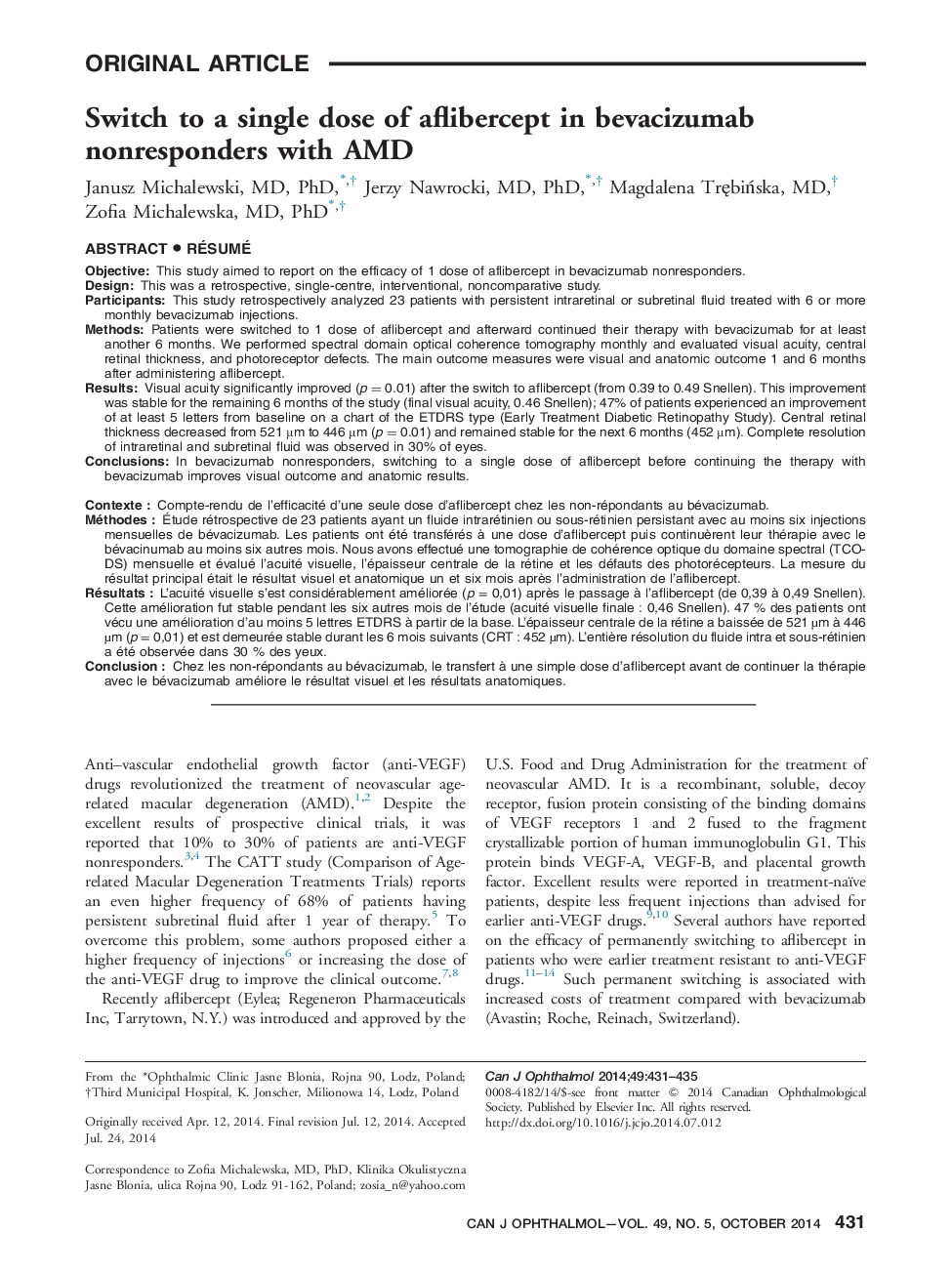| کد مقاله | کد نشریه | سال انتشار | مقاله انگلیسی | نسخه تمام متن |
|---|---|---|---|---|
| 4009188 | 1602401 | 2014 | 5 صفحه PDF | دانلود رایگان |

ObjectiveThis study aimed to report on the efficacy of 1 dose of aflibercept in bevacizumab nonresponders.DesignThis was a retrospective, single-centre, interventional, noncomparative study.ParticipantsThis study retrospectively analyzed 23 patients with persistent intraretinal or subretinal fluid treated with 6 or more monthly bevacizumab injections.MethodsPatients were switched to 1 dose of aflibercept and afterward continued their therapy with bevacizumab for at least another 6 months. We performed spectral domain optical coherence tomography monthly and evaluated visual acuity, central retinal thickness, and photoreceptor defects. The main outcome measures were visual and anatomic outcome 1 and 6 months after administering aflibercept.ResultsVisual acuity significantly improved (p = 0.01) after the switch to aflibercept (from 0.39 to 0.49 Snellen). This improvement was stable for the remaining 6 months of the study (final visual acuity, 0.46 Snellen); 47% of patients experienced an improvement of at least 5 letters from baseline on a chart of the ETDRS type (Early Treatment Diabetic Retinopathy Study). Central retinal thickness decreased from 521 µm to 446 µm (p = 0.01) and remained stable for the next 6 months (452 µm). Complete resolution of intraretinal and subretinal fluid was observed in 30% of eyes.ConclusionsIn bevacizumab nonresponders, switching to a single dose of aflibercept before continuing the therapy with bevacizumab improves visual outcome and anatomic results.
RÉSUMÉContexteCompte-rendu de l’efficacité d’une seule dose d’aflibercept chez les non-répondants au bévacizumab.MéthodesÉtude rétrospective de 23 patients ayant un fluide intrarétinien ou sous-rétinien persistant avec au moins six injections mensuelles de bévacizumab. Les patients ont été transférés à une dose d’aflibercept puis continuèrent leur thérapie avec le bévacinumab au moins six autres mois. Nous avons effectué une tomographie de cohérence optique du domaine spectral (TCO-DS) mensuelle et évalué l’acuité visuelle, l’épaisseur centrale de la rétine et les défauts des photorécepteurs. La mesure du résultat principal était le résultat visuel et anatomique un et six mois après l’administration de l’aflibercept.RésultatsL’acuité visuelle s’est considérablement améliorée (p = 0,01) après le passage à l’aflibercept (de 0,39 à 0,49 Snellen). Cette amélioration fut stable pendant les six autres mois de l’étude (acuité visuelle finale : 0,46 Snellen). 47 % des patients ont vécu une amélioration d’au moins 5 lettres ETDRS à partir de la base. L’épaisseur centrale de la rétine a baissée de 521 µm à 446 µm (p = 0,01) et est demeurée stable durant les 6 mois suivants (CRT : 452 µm). L’entière résolution du fluide intra et sous-rétinien a été observée dans 30 % des yeux.ConclusionChez les non-répondants au bévacizumab, le transfert à une simple dose d’aflibercept avant de continuer la thérapie avec le bévacizumab améliore le résultat visuel et les résultats anatomiques.
Journal: Canadian Journal of Ophthalmology / Journal Canadien d'Ophtalmologie - Volume 49, Issue 5, October 2014, Pages 431–435